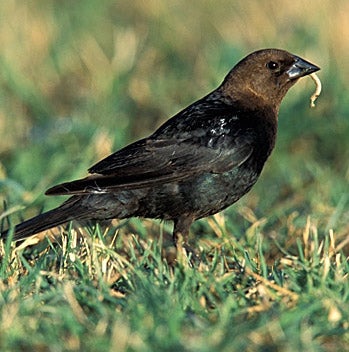SCIENTIFIC NAME:
Molothrus ater
OTHER NAMES:
Cowbird
STATUS:
Breeder. Common in all seasons and regions. Lowest Conservation Concern.
DESCRIPTION:
Brown-headed Cowbirds are small blackbirds (about 6-8inches in length) that have shorter tails and bigger round heads than most blackbirds. Cowbirds also have a more finch-like bill than other blackbirds. There bills are short and thicker at the base. Male cowbirds have a glossy black body with a brown head that sometimes has a grayish tint and looks black in sunlight. Females are all brown with lighter colored heads and bellies. They have streaking along the bellies as well and have dark eyes.
DISTRIBUTION:
Cowbirds breed throughout the continental United States and can be found as far North as Southeast Alaska and throughout portions of Canada. They are also found as far south as central Mexico. During the winter months cowbirds can be found throughout the eastern part of the United States over to Texas and Oklahoma, down into central Mexico. Cowbirds are prevalent throughout Alabama year-round.
HABITAT:
Cowbirds are most often associated with edge habitats, or scattered trees and tree lines adjacent to open grassland areas. They are often seen perched high in trees along field edges, possibly searching for host nests. They are found in thickets, prairies, old fields, pastures, and orchards. Cowbirds have also adapted well to human development and can be found in residential areas. With their association to edge habitats, increasing fragmentation of our forested lands has been beneficial to them. This has also allowed for their range to expand greatly.
During the winter months Brown-headed Cowbirds can be found in large mixed flocks of blackbird species throughout their range.
FEEDING HABITS:
Cowbirds forage on the ground, which is why they prefer open habitats such as pastures. They eat seeds and arthropods off open ground. The cowbird is named such because they are associated with horses and cows which disturb the ground flushing insects and in turn creating more foraging opportunities for these birds.
LIFE HISTORY AND ECOLOGY:
The Brown-headed Cowbird is a brood parasite, which means they do not build their own nests. Instead, the females will lay their eggs in nests of other species. This allows for the young cowbirds to be cared for and reared by other host species. Because the female cowbirds do not expend energy on nest building and brood rearing, they are able to lay up to 40 eggs per season in other species’ nests.
Females can therefore lay an average of 80 eggs, 40 eggs per year for 2 years. Of those eggs, only about 3% reach maturity or about 2.4 young per female. The more eggs that are laid by a female, the better her chances of having reproductive success. Since cowbirds do not raise their own young, there is not a close bond between males and females. Therefore, they are not monogamous breeders.
When a female cowbird lays an egg in a host nest, they will remove or sometimes even eat one of the host species’ eggs the day before or the day after they lay their egg in the nest. If the female cowbird finds a nest that has only one host egg in it, she will lay her egg and leave the host egg in the nest as well because the host species would likely abandon that nest and move on to building a new nest if she did not see one of her own eggs there.
Once cowbird eggs are laid in host nests, the cowbirds begin rapid development. The cowbird’s egg can hatch a day ahead of the host species and also tend to grow faster and larger than those nestlings of the host species. Cowbird nestlings can then have an advantage over the other nestlings when getting food because they are stronger and larger. Sometimes cowbird nestlings will even knock other eggs out of the nest or smother other nestlings to ensure they are fed.
Some species have learned to reject cowbird eggs. They can tell the difference between their eggs and cowbird eggs. Once they do, they will either abandon the nest completely or build a new nest above their old one. They will also sometimes push the cowbird eggs out of the nest. There are also some species, such as the red-winged blackbird, which recognize cowbirds as a threat and will become territorial if a female cowbird is present and try to deter them from coming near their nest.
Females will lay white to grayish-white eggs with brown markings that are usually more prevalent towards the large end of the egg. About one-third of the nests that are parasitized by cowbirds have more than one cowbird egg in them. These eggs are incubated by the host species for 10-13 days before hatching. They are then raised for 10-11 days in the nest before fledging.
Brood parasitism from cowbirds does pose a threat to birds exhibiting population declines.
REFERENCES:
Brown-headed Cowbird (Molothrus ater). 2011. Birds in Forested Landscapes (online), Cornell Lab of Ornithology.https://nestwatch.org/learn/general-bird-nest-info/brown-headed-cowbirds/
Roof, J. 1999. Molothrus ater (Online), Animal Diversity Web. https://animaldiversity.org/accounts/Molothrus_ater/.
Brown-headed Cowbird. 2010. All About Birds (online), Cornell Lab of Ornithology. http://www.allaboutbirds.org/guide/Brown-headed_Cowbird/
Author: Carrie Threadgill, Wildlife Biologist







